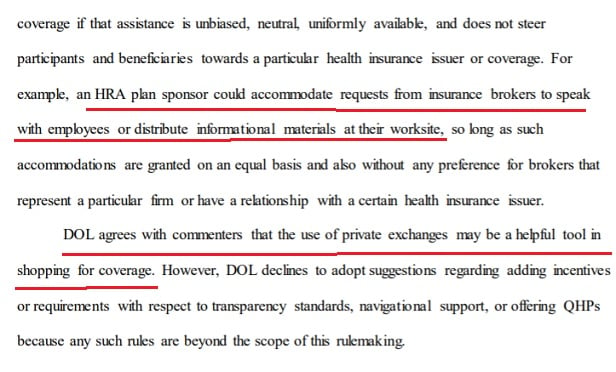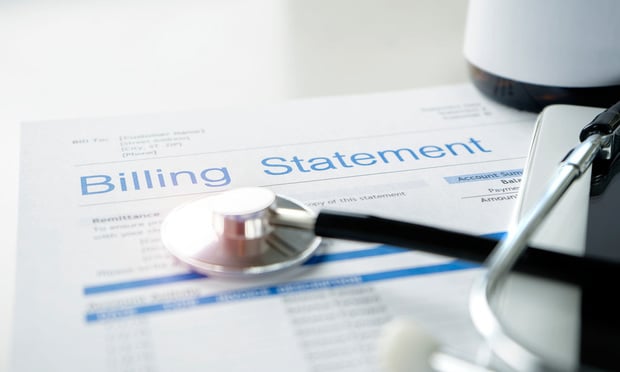 If the regulations take effect as written, and work as the drafters expect, they will apply starting with the 2020 plan year. (Image: IRS/EBSA/HHS)
If the regulations take effect as written, and work as the drafters expect, they will apply starting with the 2020 plan year. (Image: IRS/EBSA/HHS)
New final health reimbursement arrangement (HRA) regulations could encourage U.S. employers of all sizes to give workers cash the workers could use to buy their own health coverage.
The final regulations could also encourage employers to offer workers access to health insurance brokers, and to private health insurance exchange programs, to help workers understand their health coverage options.
The federal “tri agency” team — the Internal Revenue Service, the Employee Benefits Security Administration, and the U.S. Department of Health and Human Services — posted a preview version of the final HRA regulations Thursday.
Related: 7 points for employers to know about proposed HRA regulations
The tri agencies are preparing to publish the regulations in the Federal Register, an official government publication, June 20.
The schedule
Opponents of “cash for coverage” HRAs could the courts, or Congress, to keep the regulations from taking effect
Even if the regulations take effect on schedule, restrictions in the regulations, market forces or other factors could keep the regulations from working as the drafters expect.
If the regulations take effect as written, and work as the drafters expect, they will apply starting with the 2020 plan year.
The history
An HRA is vehicle that an employer uses to help employees pay for health care and health insurance.
U.S. employers have been offering HRAs and similar arrangements since the 1960s.
The Internal Revenue Service established HRA rules in 2002. Under federal law, an employer must offer another type of personal health account, the health savings account (HSA), with high-deductible health insurance. An HRA is somewhat less flexible in some ways, but an employer can offer an HRA together with ordinary, low-deductible, or no-deductible, health insurance.
When the administration of former President Barack Obama began setting up the Affordable Care Act framework for health insurance, in 2010, some health insurers and policymakers wanted to limit use of HRAs, to keep employers from using cash-for-coverage HRAs to push high-cost employees out of their health plans. The Obama administration tried to block use of cash-for-coverage HRAs, by defining a cash-for-coverage HRA as a group health insurance plan.
Obama administration officials held, for example, that, like a group health plan operating under Affordable Care Act rules, a cash-for coverage HRA would have to offer coverage without annual or lifetime benefits caps.
In the 21st Century Cures Act of 2016, Congress required the Obama administration to let small employers offer cash-for-coverage HRAs, or qualified small employer health reimbursement arrangements (QSEHRAs).
When Donald Trump became president, he made expanding employers' access to personal health account programs, including HRA programs, a priority. He later developed a health cost control strategy that made expanding HRA access one of his top three priorities.
The new regulations
The new final regulations will create two new types of HRA.
One is the individual coverage HRA, or ICHRA. An employer of any size could use an ICHRA program to give workers cash for major medical coverage. Under the regulations, an employer cannot use an ICHRA program to discriminate against older workers or sicker workers.
ICHRA users must have individual health insurance.
An employer cannot offer a worker a choice between having an ICHRA and having a traditional group health plan, and an employer cannot push the employees to use their ICHRA to buy certain types or brands of health insurance.
The Trump administration is that 800,000 employers could eventually use ICHRA programs to provide coverage for about 11 million people.
The second new type of HRA would be the excepted benefit HRA. An employer could use an excepted benefit HRA to provide up to $1,800 in cash per year, to help employees pay for supplemental coverage and cover out-of-pocket health care costs, such as health plan deductibles.
How ICHRA users would get their coverage
Officials suggest in the preamble, or official introduction, to the new final HRA regulations that some ICHRA users would get their individual health coverage from the Affordable Care Act public exchange system, and that some would buy their coverage outside of the ACA exchange system.
Officials say employers could ease employees' health coverage shopping process by letting health insurance brokers come to the worksite, or by offering the employees' private exchange programs.
“A plan sponsor may provide assistance to participants and beneficiaries in shopping for individual health insurance coverage without being considered to endorse any particular coverage if that assistance is unbiased, neutral, uniformly available, and does not steer participants and beneficiaries towards a particular health insurance issuer or coverage,” officials say. “For example, an HRA plan sponsor could accommodate requests from insurance brokers to speak with employees or distribute informational materials at their worksite, so long as such accommodations are granted on an equal basis and also without any preference for brokers that represent a particular firm or have a relationship with a certain health insurance issuer.”
Tri-agency officials say use of a well-designed private exchange could also help an employer help employees, in an unbiased and neutral way.
An ICHRA-compatible private exchange platform “would be required to present all available coverage options in a way that is entirely neutral,” officials say. “The platform could not be designed or operated in a way that limits users' ability to select a coverage option that would otherwise be available to them or that promotes one option over another (for example, with 'recommended or 'starred' listings), or the prohibition on endorsement would not be satisfied. However, an otherwise neutral platform that allows users to select certain criteria (such as a platform that allows participants to search for [high-deduction health plans] or plans that contained specific providers in their network) and search for coverage options that fulfilled these criteria would not be considered to be an endorsement by the employer.”
Resources
A preview version of the new final rule is available here.
A summary is available here.
Read more:
Complete your profile to continue reading and get FREE access to BenefitsPRO, part of your ALM digital membership.
Your access to unlimited BenefitsPRO content isn’t changing.
Once you are an ALM digital member, you’ll receive:
- Breaking benefits news and analysis, on-site and via our newsletters and custom alerts
- Educational webcasts, white papers, and ebooks from industry thought leaders
- Critical converage of the property casualty insurance and financial advisory markets on our other ALM sites, PropertyCasualty360 and ThinkAdvisor
Already have an account? Sign In Now
© 2025 ALM Global, LLC, All Rights Reserved. Request academic re-use from www.copyright.com. All other uses, submit a request to [email protected]. For more information visit Asset & Logo Licensing.








